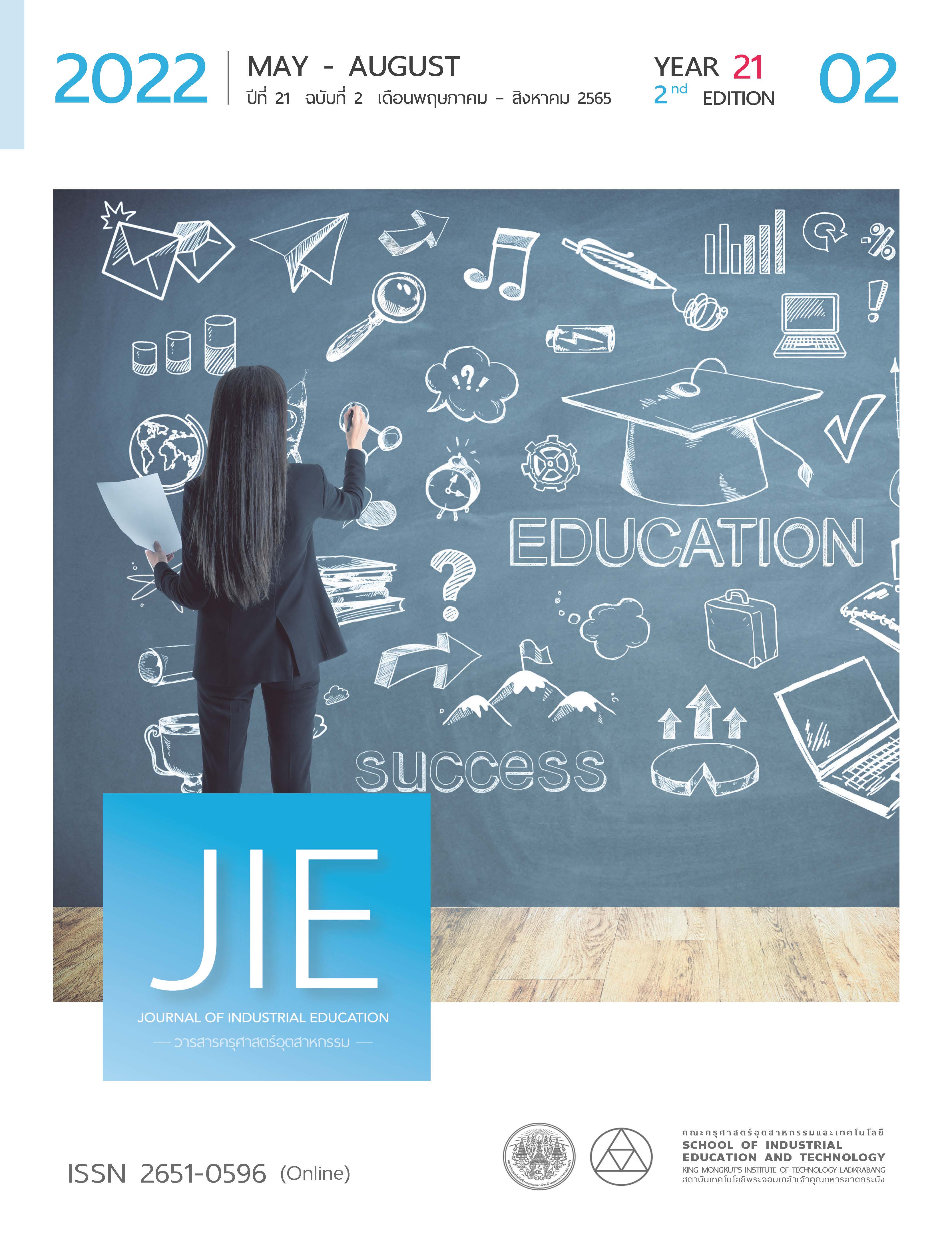ผลของความเชื่อมโยงเชิงโครงสร้างและการประเมินตามรูปแบบของการศึกษาที่มุ่งเน้นผลลัพธ์การเรียนรู้เป็นสำคัญที่มีต่อผลลัพธ์การเรียนรู้ของผู้เรียน: กรณีศึกษาในรายวิชาการปฏิบัติงานทางด้านยานยนต์
คำสำคัญ:
การศึกษาเชิงผลลัพธ์, ความเชื่อมโยงเชิงโครงสร้าง, การประเมินผลลัพธ์การเรียนรู้, การปฏิบัติงานทางด้านยานยนต์บทคัดย่อ
งานวิจัยนี้ใช้แนวทางของการศึกษาเชิงผลลัพธ์ (Outcome-based education) ในการจัดการเรียนการสอนในรายวิชาปฏิบัติทางด้านยานยนต์ เพื่อออกแบบกระบวนการของการศึกษาเชิงผลลัพธ์ให้เกิดความสัมพันธ์เชิงโครงสร้าง และให้การประเมินบรรลุผลลัพธ์การเรียนรู้ตามที่ออกแบบไว้ในผลลัพธ์การเรียนรู้ระดับหลักสูตรครุศาสตร์อุตสาหกรรมบัณฑิต สาขาวิชาวิศวกรรมเครื่องกล (ค.อ.บ. 5 ปี) การประเมินผลลัพธ์การเรียนรู้มี 5 สมรรถนะหลัก ได้แก่ การเรียนรู้ด้วยการชี้นำตนเอง
การตอบสนองและมีส่วนร่วม การอธิบายหลักการทำงานทางเทคโนโลยียานยนต์ การปฏิบัติงานทางเทคโนโลยียานยนต์ และการวิเคราะห์ปัญหาที่เกิดขึ้นทางเทคโนโลยียานยนต์ การออกแบบกระบวนการของการศึกษาเชิงผลลัพธ์ประกอบไปด้วย การออกแบบผลลัพธ์การเรียนรู้ การออกแบบกิจกรรมการเรียนรู้ และการออกแบบการประเมินผลตามผลลัพธ์การเรียนรู้ เครื่องมือที่ใช้ในการประเมินประกอบไปด้วยแบบประเมิน (รูบริค) ใบงาน และการตั้งคำถามเพื่ออธิบายถึงสาเหตุของปัญหาและการแก้ปัญหา สถิติที่ใช้ในการวิเคราะห์ผลข้อมูลคือสัดส่วนร้อยละของผู้เรียนที่บรรลุระดับผลลัพธ์การเรียนรู้ที่คาดหวัง กลุ่มเป้าหมายเป็นนักศึกษาชั้นปีที่ 2 ที่เรียนในรายวิชาทางด้านไฟฟ้ารถยนต์ จำนวน 23 คน จากผลการวิจัยพบว่า ด้านการเรียนรู้ด้วยการชี้นำตนเอง การตอบสนองและมีส่วนร่วม ผู้เรียนทั้งหมด 23 คน สามารถบรรลุผลลัพธ์การเรียนรู้ที่คาดหวังไว้ แรงจูงใจในการเรียนเกิดจากผู้สอนอธิบายให้ผู้เรียนเห็นถึงภาพรวมของการเรียนการสอนทั้งหมด ผู้เรียนรับทราบเกณฑ์การประเมินทำให้ผู้เรียนมีความกระตือรือร้นสนใจการเรียนมากยิ่งขึ้น ด้านการอธิบายหลักการทำงานทางเทคโนโลยียานยนต์ และการปฏิบัติงานทางเทคโนโลยียานยนต์ มีผู้เรียนที่ไม่สามารถบรรลุผลลัพธ์การเรียนรู้ที่คาดหวัง จำนวน 11 คน คิดเป็น 47.8% และจำนวน 7 คน คิดเป็น 30.45% ด้านการวิเคราะห์ปัญหาที่เกิดขึ้นทางเทคโนโลยียานยนต์ มีผู้เรียนที่ไม่สามารถบรรลุผลลัพธ์การเรียนรู้ที่คาดหวัง จำนวน 9 คน คิดเป็น 39.13% เนื่องจากข้อจำกัดเรื่องระดับความสามารถในการเรียนรู้ของผู้เรียนที่ไม่เท่ากัน กรอบเวลาการจัดการเรียนการสอน ข้อจำกัดในการใช้เครื่องมือประเมินเป็นครั้งแรก ทำให้ผู้เรียนบางส่วนไม่สามารถบรรลุผลลัพธ์การเรียนรู้ที่คาดหวังได้ ข้อมูลที่ได้จากงานวิจัยนี้เป็นสิ่งสำคัญที่ผู้วิจัยต้องปรับปรุงและพัฒนาต่อไปในอนาคต
เอกสารอ้างอิง
Akir, O., Eng, T., & Malie, S. (2012). Teaching and learning enhancement through outcome-based education structure and technology e-learning support. Procedia - Social and Behavioral Sciences, 62, 87–92.
Armstrong, P. (2010). Bloom’s taxonomy. https://cft.vanderbilt.edu/guides-sub-pages/blooms-taxonomy
Biggs, J. & Tang, C. (2011). Teaching for quality learning at university. (4th ed). McGraw-Hill Education.
Brookhart, S. (2013). How to create and use rubrics for formative assessment and grading. ASCD.
Dai, H., Wei, W., Wang, H., Wong, T. (2017). Impact of outcome-based education on software engineering teaching: a case study. In S. Lord (Ed.), 2017 IEEE International Conference on Teaching, Assessment, and Learning for Engineering (TALE) (pp. 261-264). IEEE.
Department of Mechanical Technology Education. (2019). Curriculum of bachelor of science in industrial education, mechanical engineering 5 years program, revised B.E. 2563. https://mte.kmutt.ac.th/bachelor.html. (in Thai)
Faldessai, N., Dharwadkar, A., & Mohanty, S. (2014). Objective-structured practical examination : A tool to gauge perception and performance of students in Biochemistry. Asian Journal of Multidisciplinary Studies. 2(8), 32-38.
Karpin, & Mahmudatussaadah, A. (2020). Student response - based learning: A strategy for improving student participation in learning. Journal of Innovation of Vocational Technology Education, 16(1), 42-52.
Mongkolteeradech, M. (2018). Outcome-based education. https://celt.li.kmutt.ac.th/km/index.php/outcomebased- triangle/comment-page-1/ (in Thai)
Othman, Z., Ya’acob, A., Azman, H., Thang, S. M., Syed Kamarulzaman, S., Hamin Stapa, S., & Wan Mohamad, W. N. A. (2014). Circuit
learning-teacher’s and student’s reactions to an innovative approach in language teaching. Journal of Institutional Research South East Asia. 12(2), 5-21.
Pinit, P., Anmanatarkul, A., & Meearsa, J. (2020). Outcome-based grading in an outcome-based education. Walailak Journal of Learning Innovations, 6(2), 59-96. (in Thai)
Pusic, M. V., Boutis, K., Hatala, R., & Cook, D. A. (2016). Learning curves in health professions education.” Academic nedicine, 90(8), 1034-1042.
Siriwongs, P. (2015, February). Developing student’ learning ability by dint of self – directed learning. 7th World Conference on Educational Sciences (WCES - 2015) (pp. 2074-2079). Novotel Athens Convention Center, Greece., 2074-2079.
Sotthayakom, P., Yoelao, D., & Suwanmonkha, S. (2018). Instructional factors of teachers: Instructional leaders and principals’ perspective. Veridian E-Journal, Silpakorn University, 11(1), 759-772. (in Thai)
Tanprasert, K. (2021). Micro-credentials for professional development for educator. Journal of Learning Innovation and Technology (JLIT), 1(1), 33-43.
Thammawattana, M. (2012). Motivation strategies to efficacy in classroom: Case study of students to practice the teaching in school, Faculty of Education, Burapha University. Journal of Education, 23(3), 17-26. (in Thai)
Tierney, R., & Simon, M. (2004). What’s still wrong with rubrics: Focusing on the consistency of performance criteria across scale levels. Practical Assessment Research & Evaluation, 9(2), 1-10.
ดาวน์โหลด
เผยแพร่แล้ว
รูปแบบการอ้างอิง
ฉบับ
ประเภทบทความ
สัญญาอนุญาต
ลิขสิทธิ์ (c) 2022 วารสารครุศาสตร์อุตสาหกรรม

อนุญาตภายใต้เงื่อนไข Creative Commons Attribution-NonCommercial-NoDerivatives 4.0 International License.
"ข้อคิดเห็น เนื้อหา รวมทั้งการใช้ภาษาในบทความถือเป็นความรับผิดชอบของผู้เขียน"



